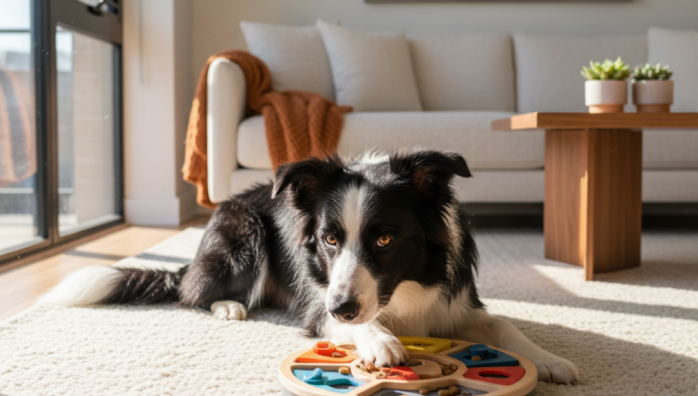Indoor Enrichment for High-Energy Apartment Dogs
by admin in Pet Care Basics 24 - Last Update November 21, 2025

When I first brought my rescue, a whirlwind of a Border Collie mix, into my 700-square-foot apartment, I honestly had a moment of panic. I\'d walk him for miles, but he\'d come inside, take a quick drink, and then start pacing, staring at me with those intense eyes. I thought, \'What have I done?\' It took me a few chewed-up running shoes to realize that I was missing a huge piece of the puzzle: mental exercise.
Why long walks are not enough
I learned the hard way that for intelligent, high-drive breeds, physical exhaustion is only half the battle. They were bred to work, to think, and to solve problems. Just tiring out their legs leaves their brains buzzing with unused energy, which often leads to destructive behaviors. The real game-changer for us was shifting my focus from just \'walking\' to \'enrichment.\' A 15-minute scent game can tire my dog out more effectively than an extra 30-minute leash walk ever could.
My go-to brain games for small spaces
You don\'t need a huge house to keep a smart dog satisfied. It\'s all about being creative with the space you have. These are the strategies that genuinely saved my sanity and built a stronger bond between us.
Sniffing and scent work
A dog\'s nose is its superpower, and letting them use it is one of the best ways to provide mental stimulation. I started simply. I\'d have my dog sit and stay, then I\'d hide a few high-value treats around the living room. At first, I made it easy, but now he can find a single treat hidden under a specific book on the bookshelf. Another favorite is the \'snuffle mat\' or even just a rolled-up towel with treats inside. He has to work to get the food out, engaging his brain and natural foraging instincts.
Interactive puzzle toys and feeders
I\'ve completely stopped feeding my dog from a regular bowl. Why give away for free what they are wired to work for? We use puzzle feeders for every meal. We started with simple rolling balls that dispense kibble and have since graduated to more complex sliding puzzles. It turns a two-minute meal into a 15-minute problem-solving session. It\'s crucial to supervise them, of course, and to find toys that are challenging but not so difficult they cause frustration. This is just what worked for us, but I always recommend chatting with your vet or a trainer about the best options for your specific dog.
Training new tricks and skills
Training sessions are fantastic mental workouts. We\'re not talking about rigid, formal obedience all the time. I spend about 10 minutes a day teaching fun, low-impact tricks like \'spin,\' \'play dead,\' or \'put your toys away\' in a basket. It engages his mind, reinforces our communication, and it\'s incredibly rewarding to see that \'lightbulb\' moment when he figures something new out.
The importance of a calm routine
Living in a small space, I\'ve found that a predictable routine helps manage my dog\'s energy levels. He knows that after his morning walk comes breakfast in a puzzle toy. He knows that mid-afternoon is our \'trick training\' time. And he knows that in the evening, after his last potty break, he gets a long-lasting chew to help him settle down. This structure prevents him from getting antsy and demanding attention because he knows what to expect, and that a fun, engaging activity is always just around the corner.
Ultimately, I\'ve discovered that having a high-energy dog in an apartment is not only possible but can be incredibly rewarding. It forces you to be a more creative and engaged owner, strengthening your bond in ways a big backyard never could. If you\'re ever worried about specific destructive or anxious behaviors, please consider consulting a certified professional dog trainer or your veterinarian.











